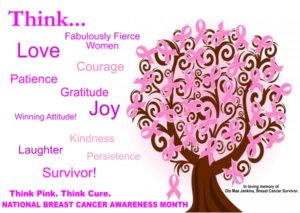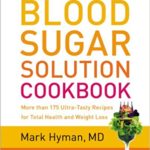October is Breast Cancer Awareness Month
 Let’s talk about breast cancer. It’s the most common cancer affecting women in the US, which means it’s time to think more about prevention. Environmental toxins, stress, and the food we eat can increase our risks for all cancers. Why not do anything and everything possible to keep ourselves and our families healthy and vital?
Let’s talk about breast cancer. It’s the most common cancer affecting women in the US, which means it’s time to think more about prevention. Environmental toxins, stress, and the food we eat can increase our risks for all cancers. Why not do anything and everything possible to keep ourselves and our families healthy and vital?
The first, and, I think, most important thing we can do to reduce our risk is to stop eating so much sugar. And I don’t mean to simply cut white sugar out of your coffee, or stop adding it to your breakfast cereal. If you still do those things, please stop, but please also realize that sugar is added to just about EVERYTHING! Reading the ingredient labels has become vital in this day and age.
For instance, I purchased orange juice the other day. It was the brand that I normally buy which the ingredients are: freshly pasteurized orange juice. Period. That’s the whole list. Which is why I buy that particular brand. I was not paying as much attention as usual, however, when I bought the same brand this particular day But not the same type. I didn’t notice, until I tasted it, that this label said, “45% less calories.” Hmmmmmm. That would seem to be a good thing, right? NOT! The ingredient list was almost a mile long and contained stevia and water and “Natural Flavors.” I was so angry that I’d purchased the wrong one. But then I realized that I could use it as a lesson in reading labels. Just because the advertising on the label makes it sound healthier, doesn’t mean it is.
Read the ingredients on the label – always – every label!
And orange juice is not the only food item that does this. Read the label of any and all food items before you bring them into your home. Many things like granola bars, bread, canned fruit and others have extra, added sugar. “Natural Flavors” is another advertising ploy. This is a category of items that can include monosodium glutamate and a whole bunch of oils that you do not want to ingest.
And ladies, when we eat sugar, it creates insulin in our bodies. High insulin levels are linked to inflammation and cancer cell growth. Sugar is food for cancer cells. High insulin levels also increase your estrogen levels. High estrogen levels mean increased breast cancer risk. Increased insulin also means your body becomes really good at storing fat, which translates to you being unable to lose those last few pounds you’ve been trying to lose. And, guess what? Fat cells can make more estrogen. Do you see the pattern here?
More bad news for many is that alcohol is high in sugar. Mommy truly does NOT need that glass of wine if it leads to three or four glasses… Too much alcohol can cause chronic inflammation of the pancreas (pancreatitis), which then impairs its ability to secrete insulin.
The best cancer prevention is your lifestyle and dietary choices. So, make sure that you are getting some exercise each week. Start a walking group, take up swimming, fit whatever you can into your daily life, but make it something you love to do so that you’ll keep doing it!
Then, limit refined sugar and begin eating lots of colorful vegetables with phytonutrients, plant compounds that have cancer fighting properties. There are so many to choose from:
Red and yellow peppers, carrots, beets, tomatoes, squash, leafy greens like spinach, kale, bok choy, broccoli, swiss chard, romaine, garlic, onions, leeks, berries, cantaloupe, peaches, citrus fruits.
Many docs suggest eating a rainbow of fruits and veggies every day. For your best cancer prevention, try to get 9-12 different sources of phytonutrients in your diet on a regular basis.
Notice that I didn’t say to go cold turkey and stop ALL sugar, although if you have had breast cancer, your doctor may have already suggested that you do that. Instead of adding white sugar to your baking or coffee, or cereal, try a drop of maple syrup. It’s so sweet that you don’t need more than a drop and it’s a plant based food. Coconut sugar is also available in most grocery stores. If prevention is what you’re looking for, you can easily take a few simple steps to guide your body in the right direction. This week when you shop, purchase more colorful veggies and try out some different recipes.
Here are some examples of how to get 9 -12 varieties in:
Blueberries, strawberries, and yogurt for breakfast
A salad made with three different leafy greens, tomatoes, red onions, yellow and red peppers, topped with a bit of salmon or chicken and maybe half a peach for lunch.
At dinner, try bok choy, garlic, and ginger with your fish, and perhaps a side salad or some broccoli, or butternut squash.

Today I have included a recipe we tried a few months ago from my friend Dr. Mark Hyman’s cookbook, “The Blood Sugar Solution.” Up until we tried it, we had not used bok choy in our cooking, but it’s so delicious that we’ve been trying it with chicken and other fish, and just about anything else we like eating – I even grew some in my garden this year! Yummmm.
Enjoy!
Sesame-Crusted Sole, Baby Bok Choy & Wild Rice
Ingredients:
4 heads of baby bok choy, trimmed
2 Tbsp. sesame oil
1/4 cup sesame seeds
2-3 large garlic cloves, minced
1 inch piece of freshly grated ginger
2 (4 oz) Sole fillets
salt and pepper
Preparation:
- Place the sesame seeds on a plate. Lightly rub the sole with 1 Tbsp. of the sesame oil, then press the sole into the sesame seeds to form a crust. Set aside.
- Heat a large skillet over medium high heat. Add the remaining 1 Tbsp. sesame oil. Carefully lay the sole in the skillet and cook until golden brown (2-3 minutes each side) Remove the sole from the pan and set on a plate.
- Add the bok choy, garlic, and ginger to the skillet. Toss well, until the bok choy is wilted. Place the bok choy mixture over a serving of steamed Wild Rice, and set the fish on top.
Let me know how you like it!
Best of Health,
Kathi



